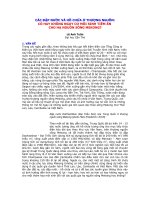Oleary2012Comp ppt ch12
Bạn đang xem bản rút gọn của tài liệu. Xem và tải ngay bản đầy đủ của tài liệu tại đây (2.37 MB, 28 trang )
Chapter 12: Databases
McGraw-Hill
Copyright © 2012 The McGraw-Hill Companies, Inc. All rights
reserved.
mputing Essentials 2012: Making IT Work for You
Competencies (Page 1 of 2)
• Distinguish between the physical and
logical views of data
• Describe how data is organized:
characters, fields, records, tables, and
databases
• Define key fields and compare batch
versus
real-time processing
• Describe databases, including the need
for databases, and database
management systems (DBMS)
McGraw-Hill
Copyright © 2012 The McGraw-Hill Companies, Inc. All rights
reserved.
12-2
mputing Essentials 2012: Making IT Work for You
Competencies (Page 2 of 2)
• Describe the five common
database models:
hierarchical, network,
relational, multidimensional,
and object-oriented.
• Distinguish among individual,
company, distributed, and
commercial databases.
• Discuss strategic database
uses
and security concerns.
McGraw-Hill
Copyright © 2012 The McGraw-Hill Companies, Inc. All rights
reserved.
12-3
mputing Essentials 2012: Making IT Work for You
Introduction to
Databases
• Like a library, secondary
storage
is designed to store
information
• End users need to understand
– How such stored information is
organized using data field,
records, files and databases
– The different types of databases
and structures
• Competent end users need to
be able to find information
that is stored in databases
McGraw-Hill
Copyright © 2012 The McGraw-Hill Companies, Inc. All rights
reserved.
12-4
mputing Essentials 2012: Making IT Work for You
Data
• Examples of data include
– Facts or observations about people,
places, things, and events
– Audio, music, photographs, and
video
• Two ways to view data
– Physical view
– Logical view
McGraw-Hill
Copyright © 2012 The McGraw-Hill Companies, Inc. All rights
reserved.
12-5
mputing Essentials 2012: Making IT Work for You
Data Organization
•
•
•
•
•
•
•
•
Character
Field
Record
File
Table
Database
Key Field
Batch Versus Real-Time Processing
McGraw-Hill
Copyright © 2012 The McGraw-Hill Companies, Inc. All rights
reserved.
12-6
mputing Essentials 2012: Making IT Work for You
Key Field
• Unique identifier also known as
primary field
• Common examples
–
–
–
–
–
McGraw-Hill
Social Security Number
Student Identification Numbers
Employee Identification Numbers
Part Numbers
Inventory Numbers
Copyright © 2012 The McGraw-Hill Companies, Inc. All rights
reserved.
12-7
mputing Essentials 2012: Making IT Work for You
Batch Processing
• Batch processing
– Data is collected over a period of time
and the processing happens later all at
one time
McGraw-Hill
Copyright © 2012 The McGraw-Hill Companies, Inc. All rights
reserved.
12-8
mputing Essentials 2012: Making IT Work for You
Real-Time Processing
• Real-time processing
– Also known as online processing because
it happens immediately during the
transaction
McGraw-Hill
Copyright © 2012 The McGraw-Hill Companies, Inc. All rights
reserved.
12-9
mputing Essentials 2012: Making IT Work for You
Databases
• Collection of integrated data
– Logically related files and records
• Databases address data
redundancy
and data integrity
ã Need for databases
ã Database management
McGraw-Hill
Copyright â 2012 The McGraw-Hill Companies, Inc. All rights
reserved.
12-10
mputing Essentials 2012: Making IT Work for You
Need for Databases
• Sharing
ã Security
ã Less data
redundancy
ã Data integrity
McGraw-Hill
Copyright â 2012 The McGraw-Hill Companies, Inc. All rights
reserved.
12-11
mputing Essentials 2012: Making IT Work for You
Database Management
• DBMS engine
• Data definition
subsystem
– Data dictionary
• Data manipulation
subsystem
– Query-by-example
– Structured query language (SQL)
ã Application generation subsystem
ã Data administration subsystem
McGraw-Hill
Copyright â 2012 The McGraw-Hill Companies, Inc. All rights
reserved.
12-12
mputing Essentials 2012: Making IT Work for You
DBMS Structure
• DBMS programs are designed to work
with data that is logically structured or
arranged
• Data models define rules and
standards for data in a database
• Five common data models are
–
–
–
–
–
McGraw-Hill
Hierarchical database
Network database
Relational database
Multidimensional database
Object-oriented database
Copyright © 2012 The McGraw-Hill Companies, Inc. All rights
reserved.
12-13
mputing Essentials 2012: Making IT Work for You
Hierarchical Database
• Fields or records are structured in
nodes
• Nodes are points connected like
branches
• One parent per node; a parent has
several
child nodes (one-to-many
relationship)
McGraw-Hill
Return
Copyright © 2012 The McGraw-Hill Companies, Inc. All rights
reserved.
12-14
mputing Essentials 2012: Making IT Work for You
Network Database
• Hierarchical node arrangement
• Each child node may have more than
one parent node (many-to-many
relationship)
• Additional nodes are called pointers
• Nodes can be reached through
multiple paths
McGraw-Hill
Return
Copyright © 2012 The McGraw-Hill Companies, Inc. All rights
reserved.
12-15
mputing Essentials 2012: Making IT Work for You
Relational Database
•
•
•
Data stored in table called a relation
Tables consist of rows and columns
Tables related via a common data
item
McGraw-Hill
Return
Copyright © 2012 The McGraw-Hill Companies, Inc. All rights
reserved.
12-16
mputing Essentials 2012: Making IT Work for You
Multidimensional
Database
• A variation and an extension of the
relational model to include additional
dimensions, sometimes called a data
cube
• Good for representing complex
relationships
• Advantages over relational
– Conceptualization
– Processing speed
McGraw-Hill
Return
Copyright © 2012 The McGraw-Hill Companies, Inc. All rights
reserved.
12-17
mputing Essentials 2012: Making IT Work for You
Object-Oriented
Database
• Works with unstructured data
–
–
–
Photographs
Audio
Video
• Objects contain both
data and instructions
• Organize using objects,
classes, entities,
attributes, and methods
McGraw-Hill
Return
Copyright © 2012 The McGraw-Hill Companies, Inc. All rights
reserved.
12-18
mputing Essentials 2012: Making IT Work for You
Types of Databases
• Individual
ã Company or shared
ã Distributed
ã Commercial
McGraw-Hill
Copyright â 2012 The McGraw-Hill Companies, Inc. All rights
reserved.
12-19
mputing Essentials 2012: Making IT Work for You
Individual Databases
• Also called a microcomputer
database
• Integrated file collection for one
person usually under the
person’s direct control
• Generally stored on the user’s
hard-disk drive or on a LAN file
server
McGraw-Hill
Return
Copyright © 2012 The McGraw-Hill Companies, Inc. All rights
reserved.
12-20









